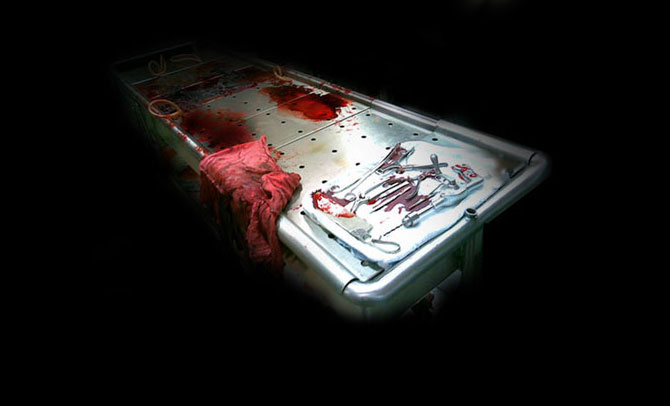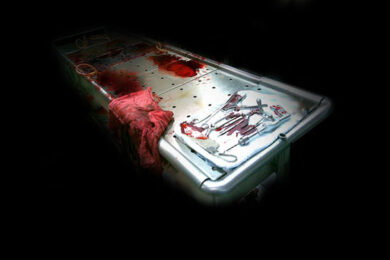Long story short… some years ago, precocious teenager Joan and her friend accept hospitality from some weirdo in a cemetery morgue/house and find themselves drugged and subsequently strapped to pathologist’s benches by said weirdo. Gruesome scenes ensue as the friend is systematically tortured in a variety of unpleasant and _scar_ring ways and the perpetrator encourages Joan to put an end to her misery by granting him permission to kill her. Joan’s response to this terrible conundrum is to weep and expel snot before ultimately acquiescing to his request. She weeps further and escapes. Ten years later she is a physically and emotionally _scar_red spinster played on autopilot by Angela ‘May’ Bettis. When murders begin to occur in her small town which carry the modus operandi of her supposedly long dead tormentor, Joan must convince the authorities that he is back.
Or that she isn’t mad and doing it due to her psychological _scar_s.
Or that someone else is doing it.
Or something.
Cue by-the-numbers torture-porn nonsense culminating in a ‘twist’ that will be all too obvious to anyone who has seen Dexter or has a brain capable of deciphering subtext.
There is very little to say about Scar that couldn’t be said about the entire parade of dogshit titles that masquerade as horror cinema in the 21st century. Perhaps the most intriguing element of the whole misguided escapade is the casting of the main (or is he?) villain Bishop. Ben Cotton has graced the small screens for a couple of years now with Trucker/Drug Dealer/Bartender bit parts in TV shows. Apparently the makers of Scar decided that having a charismatic and magnetic villain was too unrealistic and problematic for a serial killer flick so they cast Cotton, made him wear a baret, sat back and thought ‘Now there is a perfectly bland and forgettable nobody whom the audience will forget five minutes after he leaves the screen’. The fact that they dressed him like the spectacularly un-menacing front man of soulful popsters Curiosity Killed the Cat may have been their attempt to age the opening scenes but was more likely evidence of their rank idiocy. Since his spell filming Scar, Cotton has returned to familiar ground as ‘Terrified Man’ in an episode of Battlestar Galactica.
So to sum up Scar is rubbish. All the more surprising then that it should be the first horror film to take advantage of the next generation high definition 3D technology – Real D – as showcased by Beowulf and Journey to the Centre of the Earth.
3D is nothing new in horror cinema; in fact it has been around nearly as long as crap genre flicks like Scar. Most of the major studios dabbled in 3D films from the early fifties onwards but the true champions were b-movie stalwarts and gimmick enthusiasts like William Castle. Sadly, the technical complications of the process and financial constraints on theatres ensured that it would be a short-lived fad, though not as short-lived as Castle’s electrocution of audiences during the first run of The Tingler.
Despite some brief flirtations with new variations of the technology, it was not until the 1980s that 3D made any kind of comeback. A new process known as Spacevision debuted in 1981 but it was only in 1983 that it captured the public imagination when it was featured in the delicious Spacehunter: Adventures in the Forbidden Zone. Filmmakers jumped on the bandwagon, horror maestros in particular accurately divining the marketing value of the 3D label. Thus 1983 saw the release of a trifecta of horror franchise entries taking advantage of not only the leap in technology but the marketing opportunity made available by cynically manufactured sequels. Amityville 3D, Friday the 13th 3D and Jaws 3D all managed to make bundles of money despite being really, really shit. Once again the buzz was short lived and double bills would never be the same again. Although, there are those of us that would sell our grandmothers to ginger Nazi pseudo-scientists in return for a time tunnel to the theatrical coupling of Jaws 3D and epic Charles Band masterpiece Metalstorm: The Destruction of Jared Syn.
Ultimately Spacevision was just another gimmick that never really provided an immersive experience, just static images that looked displaced from the screen. Later, when viewed on televisions without 3D specs, these effects looked rotten. See the dismembered leg and looming shark effects in Jaws 3D for further evidence.
This is what makes Real D different and what establishes it as the first truly immersive 3D experience. Thanks to the high tech process, the effects can be applied throughout the film, subtly enhancing set pieces as well as the obligatory stuff jutting out at the camera. The result is deep and subtly layered. If Scar 3D accomplishes one thing it proves that something quite remarkable could be done with this technology (depending of course on the imagination and talent of the filmmakers). Dental torture scenes with in-mouth POV and implements looming out of the screen are only momentarily entertaining, as are fit girls stripping and offering you their bikini top. Ultimately they are as gimmicky as the skeleton-on-a-pulley tricks used by William Castle to terrify audiences in the 1950s and that is only one of the problems with 3D. Any audience that walks into a cinema and dons a pair of 3D specs will instantly feel removed from the film and sit back expecting to be blown away. Scar 3D was never going to accomplish that. Nipples aside, the best use of the technology in the film was the opening credits and they were farmed out to a specialist graphics house and not created by the filmmakers.
There is however a benefit to watching a lousy movie with these all new high-tech specs on. Since the same Real D process is being utilised in James Cameron’s eagerly anticipated science fiction opus Avatar it would be better for everyone to get used to the prospect of 3D specs (and the fact that turning them upside down can make you vomit and have fits) before the really good stuff comes out.



